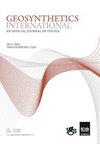锚固土工膜衬垫张力的机器学习建模
IF 2.8
2区 工程技术
Q2 ENGINEERING, GEOLOGICAL
引用次数: 1
摘要
土工膜衬垫(GM)锚固在城市生活垃圾填埋场的沟槽中,当施加的拉应力超过衬垫的极限强度时,衬垫就会发生拉出破坏。本研究利用机器学习(ML)技术估算了GM尾管抗锚固拔失稳的抗拉强度。本文采用了多层感知器(MLP)、极端梯度增强(XGB)、支持向量回归(SVR)、随机森林(RF)和局部加权回归(LWR) 5种机器学习模型。研究了锚固几何形状、土密度和界面摩擦力对土工膜抗拉强度的影响。本研究采用1520个土-土工膜界面摩擦试样。ML模型分别用90%和10%的数据进行训练和测试。使用决定系数(R2, R2adj)和均方误差(MSE, RMSE)对ML模型的性能进行统计检验。此外,使用外部验证模型和K-fold交叉验证技术来检查模型的性能和准确性。在选择的ML模型中,MLP模型在准确预测GM衬板抗拉强度方面优于MLP模型。该方法可用于抗拉强度估算,并可用于垃圾填埋场设计。本文章由计算机程序翻译,如有差异,请以英文原文为准。
Machine learning modelling of tensile force in anchored geomembrane liners
Geomembrane liners (GM) anchored in the trenches of municipal solid waste (MSW) landfills undergo pullout failures when the applied tensile stresses exceed the ultimate strength of the liner. Present study estimates the tensile strength of GM liner against pullout failure from anchorage with the help of machine learning (ML) techniques. Five ML models, viz. multilayer perceptron (MLP), extreme gradient boosting (XGB), support vector regression (SVR), random forest (RF) and locally weighted regression (LWR) were employed in this work. The effect of anchorage geometry, soil density and interface friction are studied with regard to the tensile strength of geomembrane. In this study, 1520 samples of soil-geomembrane interface friction were used. The ML models were trained and tested with 90% and 10% of data, respectively. The performance of ML models was statistically examined using the coefficients of determination (R2, R2adj) and mean square errors (MSE, RMSE). In addition, an external validation model and K-fold cross-validation techniques are used to check the models’ performance and accuracy. Among the chosen ML models, MLP was found to be superior in accurately predicting the tensile strength of GM liner. The developed methodology is useful for tensile strength estimation and beneficially employed in landfill design.
求助全文
通过发布文献求助,成功后即可免费获取论文全文。
去求助
来源期刊

Geosynthetics International
ENGINEERING, GEOLOGICAL-GEOSCIENCES, MULTIDISCIPLINARY
CiteScore
6.90
自引率
20.00%
发文量
91
审稿时长
>12 weeks
期刊介绍:
An online only, rapid publication journal, Geosynthetics International – an official journal of the International Geosynthetics Society (IGS) – publishes the best information on current geosynthetics technology in research, design innovation, new materials and construction practice.
Topics covered
The whole of geosynthetic materials (including natural fibre products) such as research, behaviour, performance analysis, testing, design, construction methods, case histories and field experience. Geosynthetics International is received by all members of the IGS as part of their membership, and is published in e-only format six times a year.
 求助内容:
求助内容: 应助结果提醒方式:
应助结果提醒方式:


